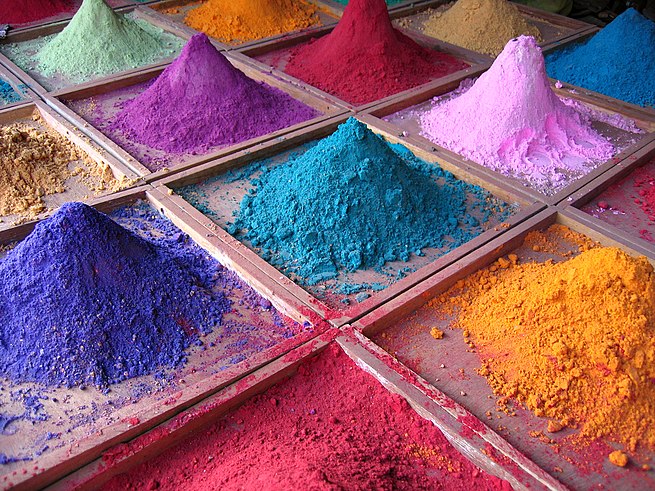
Main Difference
The main difference between Dyeing and Dying is that the Dyeing is a process of adding color to textile products like fibers, yarns, and fabrics and Dying is a permanent cessation of vital functions.
-
Dyeing
Dyeing is the application of dyes or pigments on textile materials such as fibers, yarns, and fabrics with the objective of achieving color with desired fastness. Dyeing is normally done in a special solution containing dyes and particular chemical material. Dye molecules are fixed to the fibre by absorption, diffusion, or bonding with temperature and time being key controlling factors. The bond between dye molecule and fibre may be strong or weak, depending on the dye used. Dyeing and printing are different applications; in printing color is applied to a localized area with desired patterns and in dyeing it is applied to the entire textile.
The primary source of dye, historically, has been nature, with the dyes being extracted from animals or plants. Since the mid-19th century, however, humans have produced artificial dyes to achieve a broader range of colors and to render the dyes more stable to washing and general use. Different classes of dyes are used for different types of fiber and at different stages of the textile production process, from loose fibers through yarn and cloth to complete garments.
Acrylic fibers are dyed with basic dyes, while nylon and protein fibers such as wool and silk are dyed with acid dyes, and polyester yarn is dyed with disperse dyes. Cotton is dyed with a range of dye types, including vat dyes, and modern synthetic reactive and direct dyes.
-
Dying
Death is the cessation of all biological functions that sustain a living organism. Phenomena which commonly bring about death include aging, predation, malnutrition, disease, suicide, homicide, starvation, dehydration, and accidents or trauma resulting in terminal injury. In most cases, bodies of living organisms begin to decompose shortly after death.
Death – particularly the death of humans – has commonly been considered a sad or unpleasant occasion, due to the affection for the being that has died and the termination of social and familial bonds with the deceased. Other concerns include fear of death, necrophobia, anxiety, sorrow, grief, emotional pain, depression, sympathy, compassion, solitude, or saudade. Many cultures and religions have the idea of an afterlife, and also hold the idea of reward or judgement and punishment for past sin.
-
Dyeing (verb)
present participle of dye
-
Dyeing (noun)
The act by which something is dyed.
-
Dying (adjective)
Approaching death; about to die; moribund.
“The dying dog was put out of his misery with a single shot!”
“dying fire”
-
Dying (adjective)
Declining, terminal, or drawing to an end.
“In the dying moments of daylight I glimpsed a sail on the horizon.”
-
Dying (adjective)
Pertaining to death, or the moments before death.
“His dying words were of his mother.”
“until my dying day”
“his dying bed”
-
Dying (noun)
The process of approaching death; or, less precisely, death itself.
-
Dying (noun)
Those who are currently expiring, moribund.
“The battlefield was littered with the dead and dying.”
-
Dying (verb)
present participle of die
-
Dying (verb)
present participle of dye
